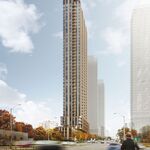subway safety
New Member
In response to Asterix and Greg,
If you live at Davisville, Yes you are right you would go in the opposite direction to go to work.
One stop to Eglinton and then straight "express" to work Yonge & Bloor.
Every train will do the same. That's why you don't need a second line.
That's why there is no bunching.
But you once again, must have platform safety.
Efficiency is not possible without safety.
Davisville is an example of a possitively affected station going in the "oppositive direction' to go to work.
Davisville has only two stops now to get to work.
From Eglinton, now you are only on the subway in a 'HALF CROWDED TRAIN".
From Eglinton it will only take about 5 minutes or 6 minutes to arrive at Yonge and Bloor.
Remember now, there would be likely no track fires.
There would be likely no subway deaths, unless they brought a sledge hammer.
There would be like little or no PAA alarms, since nobody is likely on the train from "anywhere" for more than about 25 minutes.
I would only suggest to allow the stop and creep method for Yonge and bloor, as they did on ALL SUBWAY STATION FOR 8O SOME YEARS, until they had the tragic Russel Hill Accident.
Now it would be just one station allowing for stop and creep.
This would allow the full 203% Capacity Improvement, otherwise it may be reduced to about a 100% Capacity Improvement, the lower percentage I haven't worked out yet. Still a far cry from 26% for ATC . I am not discouraging ATC, I am just using it as a comparison, cost wise and advantage wise.
Sharon.
If you live at Davisville, Yes you are right you would go in the opposite direction to go to work.
One stop to Eglinton and then straight "express" to work Yonge & Bloor.
Every train will do the same. That's why you don't need a second line.
That's why there is no bunching.
But you once again, must have platform safety.
Efficiency is not possible without safety.
Davisville is an example of a possitively affected station going in the "oppositive direction' to go to work.
Davisville has only two stops now to get to work.
From Eglinton, now you are only on the subway in a 'HALF CROWDED TRAIN".
From Eglinton it will only take about 5 minutes or 6 minutes to arrive at Yonge and Bloor.
Remember now, there would be likely no track fires.
There would be likely no subway deaths, unless they brought a sledge hammer.
There would be like little or no PAA alarms, since nobody is likely on the train from "anywhere" for more than about 25 minutes.
I would only suggest to allow the stop and creep method for Yonge and bloor, as they did on ALL SUBWAY STATION FOR 8O SOME YEARS, until they had the tragic Russel Hill Accident.
Now it would be just one station allowing for stop and creep.
This would allow the full 203% Capacity Improvement, otherwise it may be reduced to about a 100% Capacity Improvement, the lower percentage I haven't worked out yet. Still a far cry from 26% for ATC . I am not discouraging ATC, I am just using it as a comparison, cost wise and advantage wise.
Sharon.




